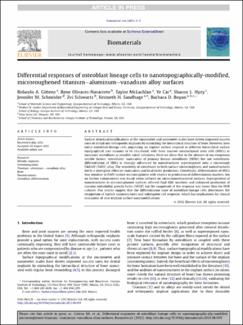Mostrar el registro sencillo del ítem
Differential responses of osteoblast lineage cells to nanotopographically-modified, microroughened titaniumealuminumevanadium alloy surfaces
| dc.contributor.author | Gittens, Rolando A. | |
| dc.contributor.author | Olivares-Navarrete, Rene | |
| dc.contributor.author | McLachlan, Taylor | |
| dc.contributor.author | Cai, Ye | |
| dc.contributor.author | Hyzy, Sharon L. | |
| dc.contributor.author | Schneider, Jennifer M. | |
| dc.contributor.author | Schwartz, Zvi | |
| dc.contributor.author | Sandhage, Kenneth H. | |
| dc.contributor.author | Boyan, Barbara D. | |
| dc.date.accessioned | 2020-07-24T17:07:16Z | |
| dc.date.available | 2020-07-24T17:07:16Z | |
| dc.date.issued | 2012-09-16 | |
| dc.identifier.other | doi: 10.1016/j.biomaterials.2012.08.059 | |
| dc.identifier.uri | http://repositorio-indicasat.org.pa/handle/123456789/219 | |
| dc.description | Surface structural modifications at the micrometer and nanometer scales have driven improved success rates of dental and orthopaedic implants by mimicking the hierarchical structure of bone. However, how initial osteoblast-lineage cells populating an implant surface respond to different hierarchical surface topographical cues remains to be elucidated, with bone marrow mesenchymal stem cells (MSCs) or immature osteoblasts as possible initial colonizers. Here we show that in the absence of any exogenous soluble factors, osteoblastic maturation of primary human osteoblasts (HOBs) but not osteoblastic differentiation of MSCs is strongly influenced by nanostructures superimposed onto a microrough Ti6Al4V (TiAlV) alloy. The sensitivity of osteoblasts to both surface microroughness and nanostructures led to a synergistic effect on maturation and local factor production. Osteoblastic differentiation of MSCs was sensitive to TiAlV surface microroughness with respect to production of differentiation markers, but no further enhancement was found when cultured on micro/nanostructured surfaces. Superposition of nanostructures to microroughened surfaces affected final MSC numbers and enhanced production of vascular endothelial growth factor (VEGF) but the magnitude of the response was lower than for HOB cultures. Our results suggest that the differentiation state of osteoblast-lineage cells determines the recognition of surface nanostructures and subsequent cell response, which has implications for clinical evaluation of new implant surface nanomodifications. | en_US |
| dc.description.abstract | Surface structural modifications at the micrometer and nanometer scales have driven improved success rates of dental and orthopaedic implants by mimicking the hierarchical structure of bone. However, how initial osteoblast-lineage cells populating an implant surface respond to different hierarchical surface topographical cues remains to be elucidated, with bone marrow mesenchymal stem cells (MSCs) or immature osteoblasts as possible initial colonizers. Here we show that in the absence of any exogenous soluble factors, osteoblastic maturation of primary human osteoblasts (HOBs) but not osteoblastic differentiation of MSCs is strongly influenced by nanostructures superimposed onto a microrough Ti6Al4V (TiAlV) alloy. The sensitivity of osteoblasts to both surface microroughness and nanostructures led to a synergistic effect on maturation and local factor production. Osteoblastic differentiation of MSCs was sensitive to TiAlV surface microroughness with respect to production of differentiation markers, but no further enhancement was found when cultured on micro/nanostructured surfaces. Superposition of nanostructures to microroughened surfaces affected final MSC numbers and enhanced production of vascular endothelial growth factor (VEGF) but the magnitude of the response was lower than for HOB cultures. Our results suggest that the differentiation state of osteoblast-lineage cells determines the recognition of surface nanostructures and subsequent cell response, which has implications for clinical evaluation of new implant surface nanomodifications. | en_US |
| dc.format | application/pdf | |
| dc.language.iso | eng | en_US |
| dc.rights | Info:eu-repo/semantics/openAccess | |
| dc.rights | https://creativecommons.org/licenses/by/4.0/deed.es | |
| dc.subject | Metallic implants Osteointegration | en_US |
| dc.subject | Titaniumealuminum evanadium | en_US |
| dc.subject | alloy Bone Nanostructures | en_US |
| dc.subject | Osteoblast differentiation | en_US |
| dc.title | Differential responses of osteoblast lineage cells to nanotopographically-modified, microroughened titaniumealuminumevanadium alloy surfaces | en_US |
| dc.type | info:eu-repo/semantics/article | en_US |
| dc.type | Info:eu-repo/semantics/publishedversion |

